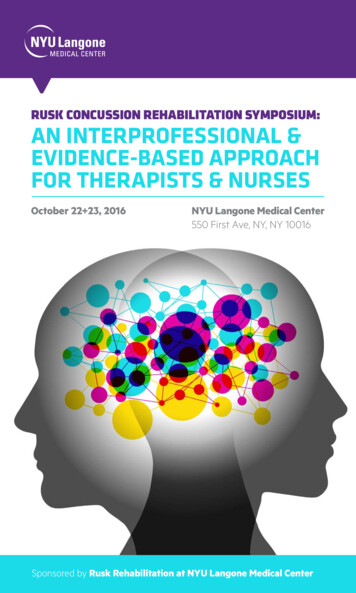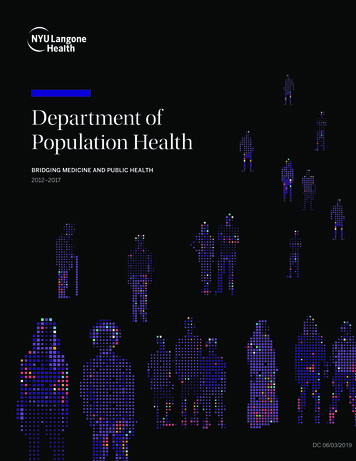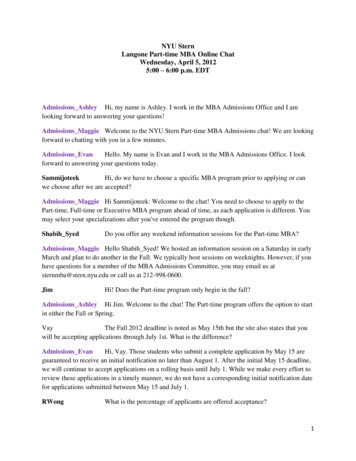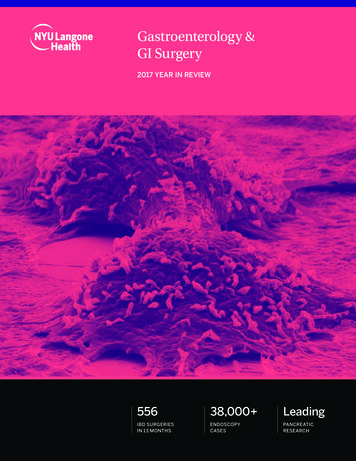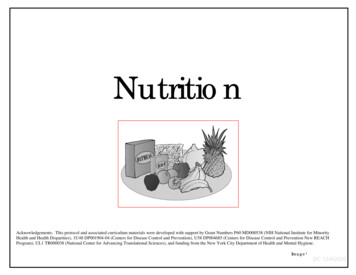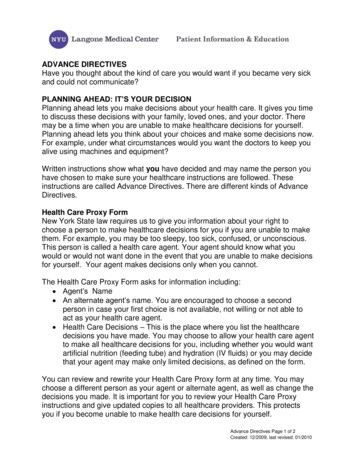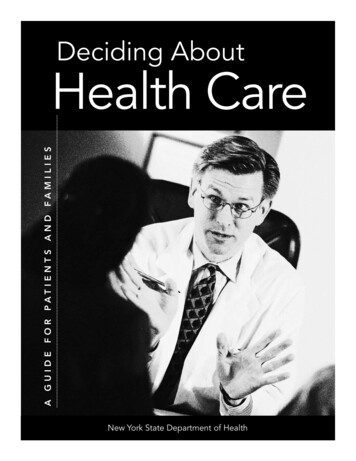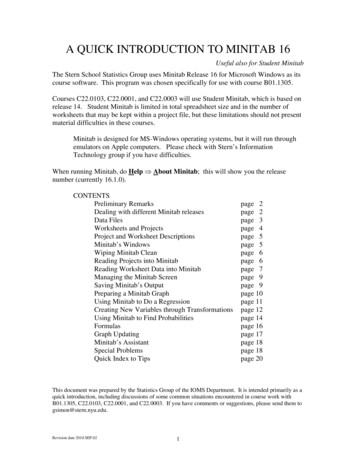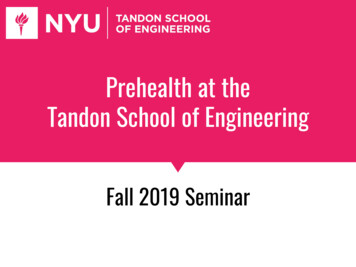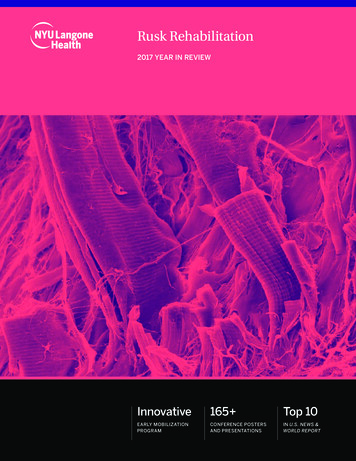
Transcription
Rusk Rehabilitation2017 YEAR IN REVIEWInnovative165 Top 10EARLY MOBILIZATIONPROGRAMCONFERENCE POSTERSAND PRESENTATIONSIN U.S. NEWS &WORLD REPORT
Contents1MESSAGE FROM THE CHAIR2FACTS & FIGURES42017 IN BRIEF102017 IN DEPTH11Rehabilitation Informs Design of New Building12Overcoming Chronic TBI in Diverse Populations14ECMO Protocol Pushes Boundaries in ICUComplex Case: Cardiogenic ShockComplex Case: Vasculitis16Early Mobilization Speeds Recovery for Critically Ill Children18Complex Case: MS Patient20ACADEMIC ACTIVITIES26FACULTY28LEADERSHIPOn the cover: Connective tissue
MESSAGE FROM THE CHAIRDear Colleaguesand Friends:STEVEN R. FLANAGAN, MD2017 was an exciting year for us at RuskRehabilitation. Our annual report highlightssome of the recent accomplishments weare most proud of—as well as the dedicatedfaculty and staff members who madethem possible.We all know that patients today have abetter chance than ever to survivemedical crises. Our challenge is thatthese survivors face many obstaclesto reestablishing their health, regainingfunction, and returning to normal life.In this field, we share a similar visionand belief: Involvement of effectiverehabilitation care is key to patient success.At Rusk, we are continuing to advancethe science of rehabilitation medicineand pioneering new efforts to increasethe value of the care we provide.This year, we continued our strategyin early mobilization that is alreadydelivering significant returns, improvingpatient outcomes and decreasing costs.Our early mobilization initiativeextended to the pediatric intensive careunit and has reduced length of stayand increased home discharge ratesfor critically ill children. Our team hasalso had success providing earlymultidisciplinary rehabilitation careHoward A. Rusk Professor ofRehabilitation MedicineChair, Department ofRehabilitation MedicineMedical Director,Rusk Rehabilitationin challenging cases, including patientson extracorporeal membraneoxygenation and individuals withcomplicated conditions.We continued to focus on cuttingedge research. One group of investigatorsis taking steps forward on a ground breaking treatment for post-stroke musclestiffness. Another inter disciplinary teamcontinued to build a strong case for anew biomarker of traumatic brain injury(TBI). Their work may one day identify anew treatment for patients strugglingwith chronic TBI.Our team is also dedicated toimproving access to rehabilitation care.Rusk was recently awarded a prestigiousTraumatic Brain Injury Model Systemgrant. We will use this funding to furtherbreak down the barriers to care forTBI patients and families, particularly indiverse communities. Other Ruskinnovators are exploring ways to useadvanced technology to overcomedisability and deliver rehabilitationservices remotely.Finally, I must mention a majorupcoming milestone for NYU LangoneHealth, the new Helen L. and Martin S.Kimmel Pavilion. This state-of-the-arthospital has been years in the making,and experts from Rusk were a key part ofplanning the building’s design. From twocomplete rehabilitation gyms to singlerooms enabling patient rehabilitation forpatients on acute care units–when theKimmel Pavilion opens its doors later thisyear, it will be set to put patients on atrajectory toward a faster recovery.On behalf of all my colleagues at Rusk,thank you for your interest in our work.We are proud to belong to a worldwiderehabilitation community that isdedicated to making sure patients notonly survive, but thrive to achieve theirgreatest potential.Rusk Rehabilitation 2017 NYU Langone Health1
FACTS & FIGURESRuskRehabilitationCLINICAL CARERESEARCH & EDUCATIONACCOLADES10923Top 10CERTIFIED SPECIALISTPHYSICAL THERAPISTSPM&R CHAIRSIN THE COUNTRYFOR REHABILITATIONaccounting for nearly10% of all certified specialistsin the state of NY2,100 INPATIENT DISCHARGESaround the U.S., both currentand former, who graduated fromRusk’s residency programin U.S. News & World Report’s“Best Hospitals” 5 M TOTAL FUNDED RESEARCH3-Year274,000 OUTPATIENT VISITS70,000 DOWNLOADS OF RUSKINSIGHTS PODCASTvia iTunes and other podcast apps30CERTIFIED REHABILIATIONREGISTERED NURSES (CRRN)including two CRRN-certifiednurse managersCARF ACCREDITATIONgranted in 2016 CIIRP, Pediatrics,Brain Injury, Stroke, and Limb Loss;exemplary conformance in researchand community outreach165 CONFERENCE POSTERS ANDPRESENTATIONSAACVPRPROGRAM CERTIFICATIONAcute CarePT ResidencyACHIEVED CAA STATUS2NYU Langone Health Rusk Rehabilitation 2017for Rusk’s Joan and Joel SmilowCardiac Prevention andRehabilitation Center
NYU Langone Health View of NYU Langone Health’s mainManhattan campus, including renderings ofthe new Science Building (left) and theHelen L. and Martin S. Kimmel Pavilion (right),both set to open in 2018.(Image credit: Ennead Architects)#19#12LeaderIN THE NATIONIN THE NATIONBEST MEDICAL SCHOOLSFOR RESEARCHIN QUALITY CARE ANDPATIENT SAFETYand nationally ranked in 12 specialties:Rehabilitation, Orthopedics,Rheumatology, Neurology &Neurosurgery, Geriatrics, Urology,Cardiology & Heart Surgery,Gastroenterology & GI Surgery,Diabetes & Endocrinology,Pulmonology, Cancer, and Nephrologyand a leader in innovation inmedical education, includingaccelerated pathways tothe MD degree5 Star RatingFROM CMS HOSPITAL COMPAREFor the past four years, NYU Langonehas received top rankings for overallpatient safety and quality of carefrom Vizient, Inc., formerly theUniversity HealthSystem Consortium.In 2017, NYU Langone received twosignificant awards from Vizient—the Bernard A. Birnbaum, MD,Quality Leadership Award andthe Ambulatory Care Quality andAccountability Award fordemonstrated excellence in deliveringhigh-quality, patient-centeredoutpatient care.NYU Langone Health is the only full service hospital in New York State and oneof 9 percent of hospitals nationwide to receive a five-star rating from the Centersfor Medicare and Medicaid Services (CMS). The rating reflects overall safety,quality, and patient experience.Rusk Rehabilitation 2017 NYU Langone Health3
2017 IN BRIEFBuilding on Existing Programsand Forging New GroundNew Kimmel Pavilion toTransform Rehabilitation CareWhen the Helen L. and Martin S. Kimmel Pavilionopens its doors in summer 2018, a host of innovativedesign features, informed by Rusk experts, will helpreimagine rehabilitation care at NYU LangoneHealth. The enhanced features begin with thefacility’s layout, designed to both accommodatethe latest technology and facilitate innovative,recovery-centered clinical practices. Single roomswill enhance infection control and early mobilization,while rehabilitation gyms and outdoor spaces willfacilitate faster recovery while encouraging wellbeing. Throughout the single rooms and sharedspaces, advanced technology such as interactivedisplays will engage patients with rehabilitationfocused educational content and collect outcomesdata. The goal of each of these enhancements, notethe Rusk leaders at the table for the building’s designdevelopment, is to set patients on a trajectory towardfaster recovery so they can regain their functionand return to their lives.Read more onPAGE 11 Rendering of the Helen L. andMartin S. Kimmel Pavilion(Image credit: Ennead Architects)4NYU Langone Health Rusk Rehabilitation 2017
Leading a Global Conversation on Technology and RehabilitationTwo Rusk Rehabilitationresearchers spoke at an event inJune during the 10th Session ofthe Conference of States Parties tothe UN Convention on the Rightsof Persons with Disabilities(UN CRPD). The event, organizedby the International Council forCaring Communities (ICCC), washeld at the United Nationsheadquarters and focused onadvanced technology that may beapplied to our global society inorder to overcome the barriersof disability.Preeti Raghavan, MDTECHNOLOGY FOR LOW-COST, SUSTAINABLE REMOTE STROKE THERAPYPreeti Raghavan, MD, associateprofessor of rehabilitation medicine andvice chair for research, discussed a newdevice that can be used to provideremote therapy for stroke survivors whohave limited function and mobility.The bimanual arm trainer (BAT)allows a patient to use his or herunaffected arm to “reconnect” the braincircuitry that controls the affected side,and ultimately help the patient regainarm function.“The exciting part about this newdevice is that the patient is the driver oftheir own rehabilitation. The BAT can beused in the convenience of their ownhome or a nearby gym. Results can betracked and reported back in a hospital-based facility,” Dr. Raghavan says. “Thetechnology can help overcome a majorbarrier to recovery for stroke survivorsall over the world: Affordable access tocontinuous rehabilitation.”BREAKING BARRIERS WITH BIONIC SENSORS AND CYBERNETICSJohn-Ross (J.R.) Rizzo, MD, assistantprofessor of rehabilitation medicineand neurology, described how wearabletechnology can help visually impairedindividuals safely navigate theirenvironment and reintegrate back intosociety in both the developed anddeveloping world.“The smart wearables combinebionic sensors with powerfulonboard computing,” Dr. Rizzo says.“Essentially, they map a low-visionpatient’s environment and reportmeaningful navigation cues throughaudio and haptics.”The core technology derives fromthe innovative world of driverless carsand pilotless drones (popularly calledunmanned aerial vehicles—UAVs).“A drone navigating around trees isanalogous to a person with low visionwalking through a bunch of scaffoldingpoles,” he says. “In terms of theunderlying technology, navigatingaround those spatial hazards is exactlythe same.” John-Ross (J.R.) Rizzo, MDRusk Rehabilitation 2017 NYU Langone Health5
Grant Drives New Research onChronic TBI in Diverse PopulationsCertified Specialist Physical TherapistsUp 22 PercentThe challenges associated with moderate to severetraumatic brain injury have grown in complexity asTBI patients live longer, and this complexity ismultiplied among patients in underservedcommunities. New Rusk research aims to applyinsights about the aging brain and TBI best practicesto improve care for culturally diverse, economicallydisadvantaged, and medically underserved patients.Rusk is one of just 16 nationwide centers funded bythe Traumatic Brain Injury Model Systems (TBIMS)program, a federal initiative that fosters innovativebrain injury research. With its five-year grant,the research team will study specific challengesassociated with chronic TBI for patients andcaregivers in the New York City area. This will lead to atoolkit of resources to help patients, caregivers, andclinicians address TBI in a culturally sensitive way.The Rusk project will help to answer critical questionssurrounding the care of this aging patient populationacross cultural and economic barriers.In 2017, NYU Langone Health had a significant increase inphysical therapists (PTs) who achieved specialist certificationthrough the American Board of Physical Therapy Specialties.A total of 28 PTs at Rusk passed their specialist certificationsthis year. Now, 40 percent of PTs at Rusk have demonstratedadvanced clinical knowledge and skills in key specialty areas.“Across our campuses, we have a total of 109 certifiedPT specialists, and 10 of these individuals have dualcertifications,” says Angela M. Stolfi, PT, DPT, Cert. MDT,director of physical therapy and PT residency and fellowshipprograms. “It’s an accomplishment that reflects ourprofessional commitment and ultimately makes a bigdifference in the level of care we are able to provide toour patients.”Rusk is a leader in New York State, holding nearly20 percent of newly certified PT specialists in 2017 and12 percent of all certified PT specialists in the state. Thatincludes 22 percent of all PTs with cardiovascular/pulmonary specialization and 28 percent of all PTs certifiedin neurology.Read more onPAGE 12Haleigh Lester, PT, DPT40%OF PTs AT RUSKhave demonstratedadvanced clinicalknowledge and skills inkey specialty areas6NYU Langone Health Rusk Rehabilitation 2017
ICU Early Mobilization Successes Extend to ECMOBuilding on earlier research pointing to enhancedoutcomes associated with early mobilization incertain ICU populations, in 2017 Rusk extended thestrategy to one of critical care’s most challenginggroups. The new protocol addresses the needs ofpatients receiving extracorporeal membraneoxygenation (ECMO), which provides much-neededstability in cases of potentially reversible cardiac orrespiratory failure but carries the side effects ofinactivity. Two recent cases highlight the benefits ofearly mobilization in this ICU population. In one,a 69-year-old man with a rapidly deterioratingcondition due to cardiogenic shock was engaged intherapy one day after conversion to veno-venousECMO. He gradually regained mobility and wasambulating at discharge. In a second complex case,a 26-year-old man with vasculitis-associatedrespiratory failure was mobilized followingECMO cannulation and regained independence bythe time of discharge 19 days later. In both cases—and more like them—Rusk experts’ carefullyorchestrated ECMO mobilization plans that helpedensure seamless therapeutic protocols andsmooth recoveries.Read more onPAGE 14Sharing the Benefits ofEarly Mobilization with Childrenin Critical CareRusk’s early mobilization findings in adults have alsobeen applied—and borne out—among critically illchildren. One of just a handful of hospitals pioneeringearly mobilization in pediatric critical care,NYU Langone launched the PICU early mobilizationinitiative in 2016, beginning with an algorithmdesigned to identify those pediatric patientsappropriately suited for the early mobilizationprotocol. The program trains nurses, therapists, andother staff in safe techniques, with an emphasis onhands-on experience. Additionally, parent volunteerswith previous experience caring for PICU patientshelp to foster understanding and acceptance of earlymobilization among families currently undergoingtreatment. These efforts have already paid off: Aninitial evaluation shows measurable outcomeimprovements due to the uptick in early mobilization,with a decrease in length of stay and an increase inhome discharge. The protocols are currently beingfine-tuned with the goal of enhancing multi disciplinary coordination, to bring even greaterbenefits to the pediatric critical care population.Continuing Medical Education:2018 CoursesMARCH 3Splinting 101: Back to BasicsMARCH 10The Rusk Complex Case Series: Rehabilitation Managementof the Patient with Complex Cardiac DiseaseMARCH 11Interdisciplinary Management of Aerodigestive Functionand Swallowing in the Medically Complex ChildMARCH 1943rd Annual PM&R ReviewAPRIL 20Injury Prevention and Performance Improvement for the Golfer:Translating Evidence into PracticeMAY 23–25Prosthetics and Orthotics for Physicians andAllied Medical ProfessionalsRead more onPAGE 16For more information go to med.nyu.edu/cmeRusk Rehabilitation 2017 NYU Langone Health7
Kimberly White, Exercise PhysiologistAs Transplant Programs Expand, Rehabilitation Plays Key RoleIn 2018, NYU Langone’s Transplant Institute will includeheart and lung transplant programs for the first time. As theseprograms take shape, transplant surgeons are involving Ruskphysiatrists in the process. The rehabilitation team is helpingto select and prepare candidates for their transplant andpromoting recovery with cardiopulmonary rehabilitationpost-surgery.“ Our team is unique in ourinvolvement at the pre-transplantpatient selection stage andwith the extensive serviceswe offer across the full continuumof transplant care.”—Jonathan H. Whiteson, MD8NYU Langone Health Rusk Rehabilitation 2017“Transplant recipients thrive when rehabilitation is closelyintegrated with the transplant program. Our team is uniquein our involvement at the pre-transplant patient selectionstage and with the extensive services we offer across the fullcontinuum of transplant care,” says Jonathan H. Whiteson, MD,assistant professor of rehabilitation medicine and vice chairfor clinical operations. “Rehabilitation is seamless aspatients transition from the outpatient clinic to the ICU, tothe surgical floor, to inpatient rehabilitation, and back intothe community.”In the days following transplant surgery, Rusk’s inpatientcardiopulmonary rehabilitation unit will provide criticalrecovery support to heart and lung transplant patients. Oncepatients are discharged, physiatrists will continue to closelymonitor recovery through regular check-ins and throughoutoutpatient cardiopulmonary rehabilitation.
Complex MS Case ConfirmsEfficacy of Intensive RehabilitationFor one patient whose multiple sclerosis (MS)treatment triggered a debilitating domino effect ofimmunological symptoms, intensive rehabilitationwas key to rapid and complete recovery. In thiscomplex case, the presentation of worsening left-sideweakness quickly deteriorated into severe disabilityin an otherwise high-functioning 44-year-old patientwith MS. MRI imaging revealed progressivemultifocal leukoencephalopathy—ultimatelyleading to a diagnosis of immune reconstitutioninflammatory syndrome (IRIS), a rare immuneresponse to MS treatment. With immunologicalcomplications in check, the Rusk team initiated amultipronged rehabilitation protocol, whichincluded progressive physical therapy and ambitiousoccupational and speech therapy strategies. Afterfour weeks of this intensive, full-spectrum treatment,the patient was discharged home—the extent of hisrecovery a testament to the comprehensive, multi disciplinary approach adopted by his Rusk care team.Read more onPAGE 184,288PATIENTShave received care atNYU Langone’s ConcussionCenter since it launched in 2013Study Strengthens Evidencefor New Concussion BiomarkerIn 2017, NYU Langone researchers used eye-trackingtechnology to study a group of college ice hockey playersduring preseason baseline assessments. Their investigation ofathletes with long-term contact sport exposure strengthenedthe evidence for a new behavioral biomarker of concussion:prolonged pauses between eye movements.The research team used infrared oculographic cameratechnology to record the ice hockey players’ eye movementswhile they performed a rapid number-naming test—a visualperformance measure that can be used as a sensitivescreening tool for concussion.“The camera lets us measure both quick eye movements,or saccades, and the rests or pauses between eye movements,the intersaccadic intervals or ISIs,” says John-Ross (J.R.)Rizzo, MD, assistant professor of rehabilitation medicine andneurology. “What we found in this group is that prolongednumber-naming times are correlated with longer ISIs, notwith slower saccades.”This investigation builds on the team’s previous ground breaking findings that concussion patients have longerintersaccadic intervals compared with healthy patients.According to Dr. Rizzo, it reinforces the importance of fixationpauses as a target for concussion research.“This study is helping us move beyond the general linkbetween eye movement and concussion and concentrate onthe ISI as a more granular focal point following post-injuryimpairment,” Dr. Rizzo says. “What this ultimately meansin terms of traumatic brain injury is a bigger question, andthat’s what we’re driving toward as we push this line ofresearch forward.”Rusk Rehabilitation 2017 NYU Langone Health9
2017 IN DEPTHRehabilitation: Pushing Boundariesfor Better Patient OutcomesJonathan H. Whiteson, MD10NYU Langone Health Rusk Rehabilitation 2017
In New Building, Rehabilitation Informs DesignAfter nearly a decade of planning, the Helen L. and Martin S. Kimmel Pavilionwill open its doors in summer 2018. Rusk Rehabilitation experts were involved inthe building’s design and development right from the start—with a vision thatincludes the latest rehabilitation technology.The opening will cap nearly a decade ofeffort by healthcare leaders, architects,and others to create a state-of-the-arthospital facility in the heart of New YorkCity. The brand-new, 830,000
PROGRAM Rusk Rehabilitation 2017 YEAR IN REVIEW NYU LANGONE HEALTH 550 First Avenue, New York, NY 10016 . NYU Langone Health is the only full service hospital in New York State and one . DPT, Cert. MDT, director of physical therapy and PT residency and fello
